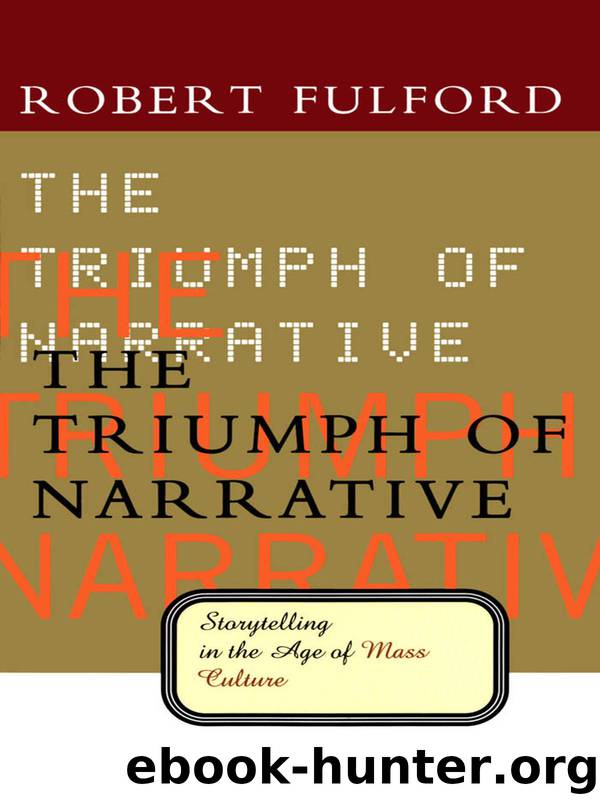The Triumph of Narrative by Robert Fulford

Author:Robert Fulford
Language: eng
Format: epub
Tags: LIT007000
Publisher: House of Anansi Press Inc.
Published: 1999-11-01T05:00:00+00:00
IV
THE CRACKED MIRROR OF MODERNITY
ANYONE’S PERSONAL HISTORY as a reader contains certain moments that in retrospect feel like beginnings, openings. When I was twelve or thirteen years old, I picked up an anthology of American short stories and came upon a piece by Ring Lardner called “Haircut.” It was then about twenty years old and was considered a classic. Its glow has since faded, and today a reader might find it obvious and overdrawn, like much of Lardner’s fiction. But for me, in 1945 or so, “Haircut,” just fifteen pages long, was a revelation, a key turning in a lock.
It introduced me to narrative ambiguity, and gave me my earliest glimpses of two subjects large enough to deserve a lifetime’s attention: the surprising forms that narrative can take and the energy that writers of the twentieth century have generated through distortions of storytelling. Stories resembling “Haircut” sometimes appeared earlier in literary history, but it is our century that has placed them near the core of literature. And it is also our century that has learned to regard the devious ways of narrative with a certain suspicion, suspicion that reached new intensity with the rise of critical studies in the universities during the last quarter of the century.
“Haircut” concerns the shooting death of an unemployed salesman, Jim Kendall, in a small town in Michigan. The narrator, a barber named Whitey, remembers Kendall with affection. “Jim certainly was a character,” Whitey tells us. He also informs us that Jim mistreated his wife and children, bragged about his adulteries, tried to rape a woman who rejected his advances, and liked to play practical jokes on Paul, a young man who was never quite right after a childhood accident damaged his brain.
Whitey speaks indulgently of his late friend Jim: “He was all right at heart, but just bubblin’ over with mischief.” Whitey describes an elaborate practical joke through which Jim humiliated Julie, the woman he tried to rape. This deeply offended the simple-minded Paul, who idolized Julie. Later, on a duck-hunting expedition, Paul shot and killed Jim.
As he tells us this story, Whitey appears to believe the death was an accident. But we can guess, from the many clues Lardner gives us, that Paul wanted to kill Jim, and that the author considers Paul the agent of justice.
Over seventy-five years or so, “Haircut” has influenced other fiction: Billy Bob Thornton’s Sling Blade, a much-admired American film of 1996, has characters closely resembling Jim and Paul, a similar dramatic situation, and roughly the same violent resolution. But the main historic interest of “Haircut” lies in the way the barber delivers the story. He’s a textbook example of what literary critics call the “unreliable narrator,” a phenomenon that was named in 1961 by the critic Wayne Booth in The Rhetoric of Fiction.
The unreliable narrator demonstrates how the spirit of the times colours the work of storytellers, and how they in turn help to shape that spirit. We can find unreliable narrators in the books of Agatha
Download
This site does not store any files on its server. We only index and link to content provided by other sites. Please contact the content providers to delete copyright contents if any and email us, we'll remove relevant links or contents immediately.
Periodization Training for Sports by Tudor Bompa(7928)
The MacArthur Bible Commentary by John MacArthur(4653)
The Body: A Guide for Occupants by Bill Bryson(4587)
The Sports Rules Book by Human Kinetics(4079)
What It Really Takes to Get Into Ivy League and Other Highly Selective Colleges by Hughes Chuck(3554)
Marijuana Grower's Handbook by Ed Rosenthal(3515)
The Sprouting Book by Ann Wigmore(3413)
The Martian by Andy Weir(3188)
Salt, Fat, Acid, Heat: Mastering the Elements of Good Cooking by Nosrat Samin(3000)
The Bread Bible by Rose Levy Beranbaum(2894)
Sapiens and Homo Deus by Yuval Noah Harari(2845)
Classic by Mary Berry(2837)
Harry Potter 4 - Harry Potter and The Goblet of Fire by J.K.Rowling(2805)
The Marketing Plan Handbook: Develop Big-Picture Marketing Plans for Pennies on the Dollar by Robert W. Bly(2798)
Martha Stewart's Baking Handbook by Martha Stewart(2677)
Screenplay: The Foundations of Screenwriting by Syd Field(2438)
The Plant Paradox by Dr. Steven R. Gundry M.D(2430)
50 Economics Classics by Tom Butler-Bowdon(2415)
The Cambridge Grammar Of The English Language by Rodney Huddleston Geoffrey K. Pullum(2318)
